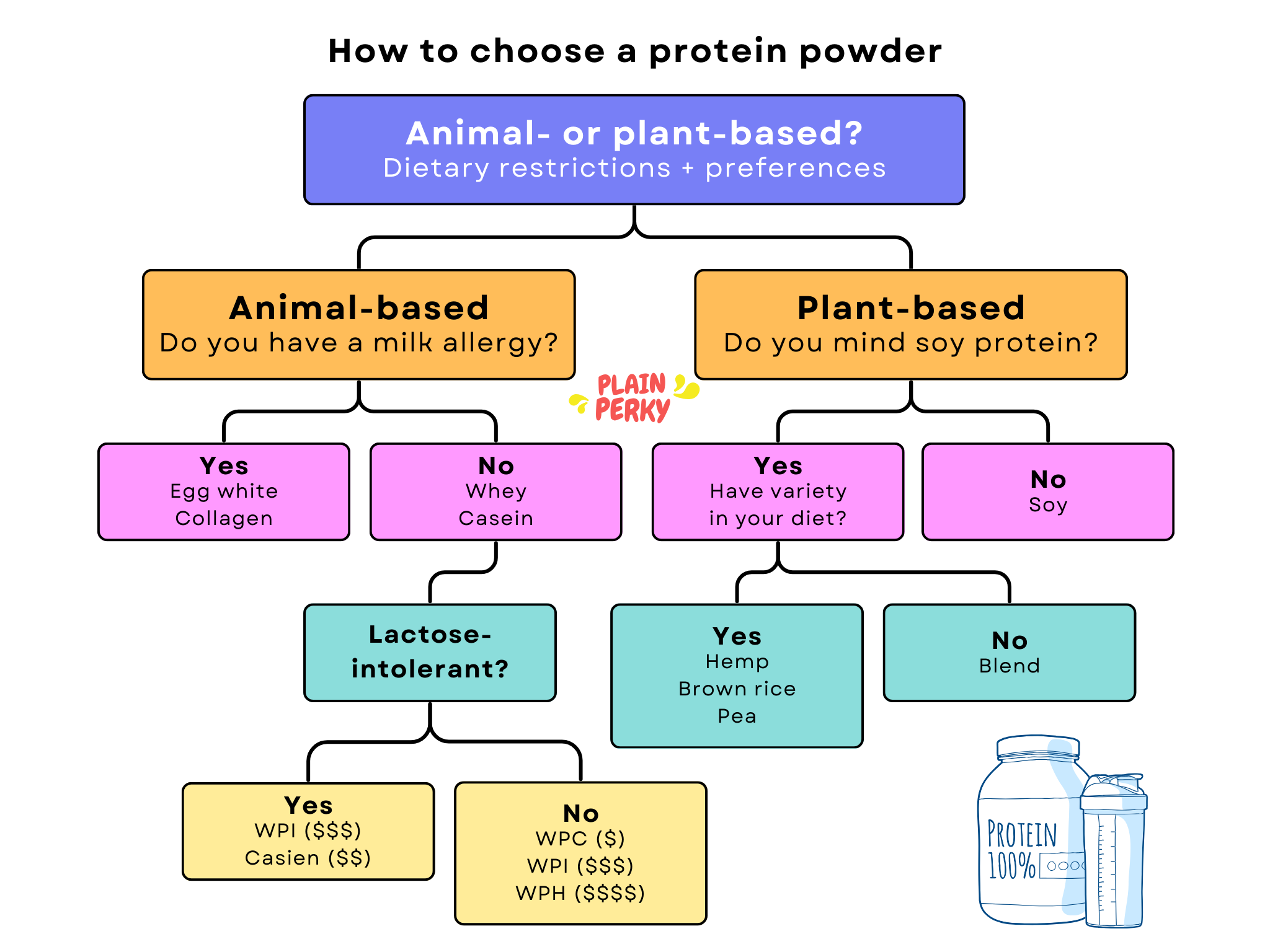9 Types of Protein Powder, Explained: Which Is Best for You?
This article helps you say goodbye to the splitting headache that is trying to choose between the different types of protein powder available.

Anyone who’s ever tried to hit their daily protein intake requirements through 100% whole foods will know all too well … to put it mildly, the associated challenges.
And while protein powders offer a much-needed lifeline (not to mention a nice break for the jaws), they present a unique problem of their own. Which should you pick? Why are there so many types of protein powder available?
Let’s work through that together in this article.
What makes a protein powder “good”?
But before diving into the 9 types of protein powder commonly available in the market, let’s first get on the same page about what distinguishes between a protein powder that’s:
- Meh at best (hey, that somehow rhymes?) vs.
- A total gains-stimulating machine
You’ll want to pay attention because this will not only help guide you in selecting the best type of protein powder (e.g., whey vs. collagen) but also the best protein powder within a specific type (e.g., brand X’s whey vs. brand Y’s whey) for you.
There are 2 key things to look out for: amino acid profile and digestibility.
Amino acid profile
Dietary proteins are made up of 20 common amino acids.
Leucine (which is 1 of the three BCAAs), in particular, is an EAA highly revered by lifters.
Why? Because it’s the EAA that has the largest effect on initiating muscle protein synthesis, or the process of making new muscle.
That said, it’s important to note that leucine doesn’t work in isolation. While it’s responsible for stimulating muscle synthesis, research shows the other 8 EAAs are required for a strong, sustained response.
So, taken together, this means types of protein powders with an amino acids profile that:
- Has a good balance of all 9 EAAs, and
- Slightly higher leucine concentrations
… work best for muscle growth purposes. We’ll talk about which those are later.
Protein digestibility
For now, though, protein digestibility.
This refers to the percentage of protein that’s available for absorption and subsequently used for building muscle after ingestion.
As you can imagine, the higher a protein’s digestibility, the better it’ll be for hypertrophy purposes.
OK, so to recap, the 2 things you’ll want to look out for in your protein powder are these:
- Amino acid profile
- Digestibility
Keep those in mind as we explore the different types of protein powder available, starting with those that are animal-based.
Animal-based types of protein powder
We’ll be upfront with you going into this section. Compared to plant-based protein powders, animal-based ones tend to have:
- A more balanced mix of all 9 EAAs, with higher leucine content and
- Higher digestibility scores
But don’t think this means all animal-based types of protein powder are better than their plant-based counterparts just yet, though.
Whaaa—?
Don’t worry, it’ll become clear once we’ve run through all 9 types of protein powder.
#1: Whey protein powder
Whey protein is the protein from whey, the liquid portion of milk that separates from the curds during cheese production.
Impressively, among all the different types of protein powder, whey tops the list for:
- Its leucine content, and
- Digestibility score
It also boasts a good balance of all 9 EAAs. There are 3 types of whey protein powder:
35% to 80% protein. Typically contains the highest amount of carbs (including lactose, the “milk sugar”) and fat, which also means it’s the most calorie-dense of all the different types of whey protein powder.
At least 90% protein. Undergoes an additional filtration process to remove carbs and fat. Typically the least calorie-dense per serving.
“Pre-digested” WPC and WPI. Despite claims of better absorption, research has not shown WPH to be any more effective at increasing muscle size or strength than WPC or WPI.
The additional processing needed for WPI and WPH means they typically cost quite a bit more than WPC.
So which whey protein should you go for? We’ll cover a list of questions that’ll help guide your answer later on.
#2: Casein protein powder
Like whey, casein is derived from milk.
It comes a close second to whey protein powder in terms of leucine content and digestibility score. The only significant difference between them?
Casein is digested and absorbed more slowly than whey.
While some argue that this could promote a more sustained MPS response and, thus, better muscle growth, it hasn’t panned out in reality.
I.e., casein isn’t “superior” to whey protein just because it’s a slower-digesting protein.
Compared to whey protein, casein protein powders tend to be less soluble and have a “creamier” texture.
If that’s the consistency you prefer, great!
If not, you might have more trouble drinking it than whey. Casein protein powders also tend to cost more than WPC.
#3: Egg white protein powder
Egg protein has many winning attributes:
But that’s when we’re talking about whole eggs. Would the same apply to the types of protein powder that's made from egg whites?
Well, unfortunately, a 2021 study published in the Journal of Strength and Conditioning Research suggests egg whites may not be as hypertrophy-stimulating as whole eggs.
The researchers randomly assigned 30 participants to 2 groups:
- Full-body resistance training (RT) + 20 grams of post-workout protein from whole eggs
- RT (same routine) + 20 grams of post-workout protein from egg whites
Both groups consumed the same total daily calories and protein throughout the day.
Interestingly, after 12 weeks, those in the whole eggs group experienced a significant:
- Increase in their quads strength
- Reduction in body fat percentage
… compared to the egg whites group.
There was also a (non-significant) trend in the whole eggs group for having a greater change in lean body mass compared to the egg white group.
While it’s still unclear why whole eggs perform “better” than egg whites, researchers believe it may come down to the former’s dietary cholesterol and/or additional nutrient content.
Um, OK, so is that a straightforward no to using egg white protein powders? Not really.
They could still be your best bet in certain scenarios, but once again, more on that later.
#4: Collagen protein powder
Collagen protein powder: does it deliver on the promise of supporting your muscle-building and beauty (think: a glowy complexion, swish-worthy hair, and chip-resistant nails 💅) goals at the same time?
Hmm. Let’s take a much-needed step back for a minute and explain what collagen is.
Collagen is the main structural protein that forms the connective tissue throughout your body, from your skin to bones, muscles, tendons, and ligaments.
With age, your body naturally starts reducing collagen production — causing “undesirables”, such as sagging skin and stiff joints.
So, theoretically speaking, topping up your body’s collagen supply with a collagen protein powder could help “reverse” the signs of aging.
And since it’s essentially a protein, it’d also help plug the gaps in your protein intake so you get the most gains possible from your training efforts.
Sounds like a win-win, but some skepticism is warranted.
- Collagen is not a complete protein: Unlike other animal-based types of protein powder, collagen only contains 8 of the 9 EAAs. What’s more, these amino acids aren’t equally balanced, as the ratio is skewed towards proline, glycine, and hydroxyproline. And in case you were wondering, it doesn’t fare well on the leucine front, either. For reference: 11 g of bovine collagen peptides contain 310 mg of leucine, almost 3.6x lower than the amount found in 11 g of whey protein concentrate (1,150 mg).
- Weak evidence on collagen’s beauty benefits: Put simply, there simply haven’t been any credible, high-quality studies linking dietary collagen supplementation (e.g., via collagen protein powders) and skin/hair/nails/joints health.
Plant-based types of protein powder
As mentioned earlier, most plant-based types of protein powder won’t provide all 9 EAAs and are usually lower in leucine content.
But turns out, despite those “shortcomings”, it’s still possible for you to experience comparable muscle growth to someone who’s using animal-based types of protein powder by simply doing 2 things:
- Hitting your daily protein requirements of 1.6 g/kg of body weight (via a wide range of plant-based protein foods + topping up with a plant-based protein powder)
- Spreading that intake out evenly across at least 3 meals daily
Also, “most” doesn’t mean all. In fact, here’s a plant-based protein powder that offers all 9 EAAs and a leucine content that could rival eggs: soy protein powder.
#1: Soy protein powder
Let’s first address the elephant in the room 🐘.
Doesn’t soy have estrogen-like properties that could do nasty things, including increase your risk of breast cancer, impair fertility, and skyrocket your heart disease risk?
Let’s look at what research actually says.
This 2014 meta-analysis of more than 30 studies published in PLoS One found that soy intake reduced the risk of breast cancer for both pre- and post-menopausal women. Soy’s cancer-protective effects don’t just stop with the breasts, either. Other studies have also shown that soy consumption may slightly lower the risk of gastrointestinal cancers and prostate cancer.
A 2016 study published in The Journal of Clinical Endocrinology & Metabolism found that women undergoing in vitro fertilization (IVF) who have environmental exposure to BPA are more likely to get pregnant if they also ate soy.
According to a 2020 study published in Circulation that examined data from 200,000 people across 3 large cohort studies, eating at least 1 serving of tofu weekly was linked to an 18% lower risk of heart disease compared to those who rarely ate tofu.
Now, of course, please don’t go to the extreme and rely on soy as your only protein source.
Moderate soy consumption has been shown to be safe and even potentially health-beneficial — but the same cannot be said for high intakes exceeding 50 mg of soy isoflavones daily (the equivalent of 200 grams of tofu or 3 cups of soy milk).
Depending on extraction and processing methods, a 30-gram scoop of soy protein powder may contain 3 to 30 mg of soy isoflavones.
And, importantly, note that the above daily soy and soy isoflavones guidelines are based on research involving the healthy general population.
If you have any underlying medical conditions or genetic predisposition to cancers, please, please, please, defer to your primary healthcare doctor for advice on how much soy (including soy protein powder) you could eat.
#2: Hemp protein powder
Hemp protein powder is derived from the seeds of the hemp plant (or Cannabis sativa).
And because you must be wondering: it only contains trace amounts of THC. I.e., it won’t get you high.
Now, 1 thing you need to know about the types of protein powder made from hemp is this: they do not contain all 9 EAAs. More specifically, hemp protein powder is short on lysine. We’ll talk about how you can circumvent this later.
#3: Brown rice protein powder
TBH, there’s nothing much to say about brown rice protein powder except that it’s made from brown rice — and, like hemp protein powder, doesn’t provide enough lysine to be considered a complete protein.
Yep. Moving on.
#4: Pea protein powder
Ah, peas.
While often proposed to be a “safer” plant-based alternative to soy protein powders, the truth is that pea protein powder isn’t a complete protein. It’s low on the EAA methionine.
#5: Plant-based protein powder blend
Wait a minute. Couldn’t we combine:
- Lysine-deficient hemp and/or brown rice with
- Methionine-deficient pea
For a plant-based protein powder blend that offers a good balance of all 9 EAAs? Yes.
That’s the exact idea behind many types of protein powders featuring a blend of different plant-based sources — pea, soy, hemp, and brown rice.
A downside to these plant-based protein powder blends? They tend to be pretty expensive.
How to choose a protein powder that works for you
Oooh. That was a lot of information.
But now, you’ve made it to what’s arguably the most important portion of this article: picking a protein powder that’s best for you (out of all the different types of protein powder available in the market!)
Here’s a handy flowchart that could help guide your decision.

Additional questions you could consider when selecting specific brands within a particular type of protein powder (e.g., pea protein powders) also include:
- How many mg of each EAA does it offer?
- How much does the protein powder cost per gram of protein?
- What do people say about the taste or consistency? (If it tastes or mixes terribly, you probably wouldn’t be able to bear with it for long.)
Alright. Since you've made it all the way down here, we'd like to say 2 things.
One, we're proud of you:
Two, you'll have a much easier time choosing between the different types of protein powder now, so go on, go add what's right for you to your cart.





